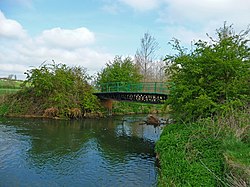Nassington
| Nassington | |
| Northamptonshire | |
|---|---|
 River Nene near Nassington | |
| Location | |
| Grid reference: | TL0696 |
| Location: | 52°33’21"N, 0°25’50"W |
| Data | |
| Population: | 670 |
| Post town: | Peterborough |
| Postcode: | PE8 |
| Dialling code: | 01780 |
| Local Government | |
| Council: | North Northamptonshire |
| Parliamentary constituency: |
Corby |
Nassington is a village in Northamptonshire, a place of just 670 souls recorded at the 2001 census. The River Nene runs along the eastern side of the parish.
Here in Nassuington is the Prebendal Manor House, one of the most historically valuable buildings in the county. The modern village property boundaries still retain much of their early mediæval origins and the manorial plot can still be distinguishable as a large block of land, with the church occupying the northeast corner.
Parish church
The parish church is St Mary the Virgin and All Saints. It stands on a promontory over looking the village, and may once have been a minster church.
Prebendal Manor House
the Prebendal Manor House, one of the most historic properties in Northamptonshire; it is the earliest surviving dwelling in Northamptonshire.
It forms the focus of a group of stone buildings, which includes a 16th century dovecote, a large 18th century tithe barn and a 15th century lodgings building.
The house is Grade I listed
Excavations in and around the Prebendal Manor at Nassington have been in progress since 1984. The accumulated archaeological data demonstrates that the Prebendal site has been used and occupied since the Stone Age. Bronze Age finds and an Early Iron Age field and fence system have been found, and Roman pottery suggesting a farmstead on the manor site. Excavations close to the southern boundary of the church uncovered the remain of a Late Saxon timber aisled hall.
Gardens
The gardens were established to represent both the practical and decorative features that could be found in a high status garden between the 13th and 15th centuries.
The New Garden is based on the 'Square Garden of Henry the Poet'. Henry was most likely to have been, 'Henricus Anglicus', who is known to have travelled to Naples and many other places. Henry Daniel praising him as 'Doctor and noble poet', quoted his writing on herbal recipes.
The ephemeral beauty of gardens was noted by many mediæval poets:
'Now shrinketh rose and lilye-flour,
That whilen ber that swete savour.
In somer, that swete tide.'
The plant list tells what was grown on each of four sides of his garden. Where there is any uncertainty as to which plant is meant in the original documents, then the possible alternatives have been planted.
The plants have been selected from several plant lists. These include the earliest gardening book by 'Jon Gardener' and a 15th century 'Leech Book' that contains the sort of medical recipes that Nicholas Colnet, who was physician to Henry 5th during the Agincourt campaign in 1415. He was given the Prebendal Manor in 1417, probably in return for his services. There is a plant identification list to accompany this garden.
Alan Titchmarsh described the gardens as a "stunning example of a recreated mediæval garden".
Tithe Barn Museum
The Tithe Barn Museum stands in the gorund of the manor house. It is managed as a registered charity.
The museum displays the history of the manor and of the prebendaries. There are recreated mediæval gardens and photographs of both the manor and the gardens.
Miscellany
The village was featured in episode 117 of Time Team (airing 7 March 2004). The goal of the excavation was 'King Cnut's Manor.